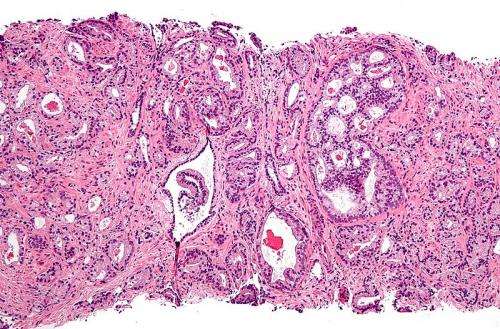Low risk of cancer spread on active surveillance for early prostate cancer

Men undergoing active surveillance for prostate cancer have very low rates - one percent or less—of cancer spread (metastases) or death from prostate cancer, according to a recent study published in The Journal of Urology, an official journal of the American Urological Association (AUA).
"In the long-term, active surveillance is a safe and viable option for men with low-risk and carefully selected intermediate-risk prostate cancer," according to the report by senior author Peter R. Carroll, MD, MPH, of University of California, San Francisco (UCSF) and colleagues.
During active surveillance, prostate cancer is carefully monitored for signs of progression through regular prostate-specific antigen (PSA) screening, prostate exams, imaging and repeat biopsies. If symptoms develop, or if tests indicate the cancer is more aggressive, active treatment such as surgery or radiation may be warranted.
New data on outcomes of active surveillance
The goal of active surveillance is to avoid or delay the side effects of treatment in men with favorable-risk disease without compromising such long-term outcomes as survival or metastasis. Dr. Carroll and his team set out to assess the long-term outcomes of men on active surveillance for prostate cancer to determine which, if any, prognostic factors could predict the risk of metastases.
The researchers analyzed 1,450 men with early-stage disease (median age 62 years) who were managed using active surveillance at UCSF between 1990 and 2018. Average follow-up was approximately 6.5 years; however, nearly one-fourth of patients were followed up for 10 years or longer.
Results showed risk of metastases during long-term active surveillance was affected by three factors:
- Gleason grade (GG), a standard measure of prostate cancer grade. On initial biopsies, 90 percent of men had low-grade prostate cancers (GG1) and 10 percent had intermediate-grade (GG2) cancers. Overall, 99 percent of patients were alive and without metastases at seven years. For those with GG2 cancers, this figure was slightly, but significantly lower: 96 percent.
- PSA velocity, or rate of change on this prostate cancer risk marker. Patients with faster increases in PSA had a higher risk of metastases.
- Multiparametric MRI. A new imaging technique called multiparametric MRI was performed in about half of patients. Men with a high likelihood of clinically significant cancer on multiparametric MRI were at higher risk of metastases.
"At seven years, one percent of men in our cohort developed metastatic disease and less than one percent died from prostate cancer," lead author Martina Maggi, MD, and coauthors write. Overall survival rates varied according to GG and PSA velocity: from 98 percent for men with GG1 cancers and slower PSA velocity to 87 percent for those with GG2 cancers.
The study provides new evidence on the benefits of active surveillance, with longer-term follow-up than most previous reports. It also provide insights into risk factors for metastases during follow-up: GG, PSA velocity, and possibly multiparametric MRI. Dr. Maggi and colleagues conclude: "These characteristics should be taken into account when selecting, following, and counseling patients for active surveillance."
More information: Martina Maggi et al. The Long-Term Risks of Metastases in Men on Active Surveillance for Early Stage Prostate Cancer, Journal of Urology (2020). DOI: 10.1097/JU.0000000000001313

















